foormusique.biz: Moving Statistics Industry Trends Data 2023
Untung99 menawarkan beragam permainan yang menarik, termasuk slot online, poker, roulette, blackjack, dan taruhan olahraga langsung. Dengan koleksi permainan yang lengkap dan terus diperbarui, pemain memiliki banyak pilihan untuk menjaga kegembiraan mereka. Selain itu, Untung99 juga menyediakan bonus dan promosi menarik yang meningkatkan peluang kemenangan dan memberikan nilai tambah kepada pemain.
Berikut adalah artikel atau berita tentang Harian foormusique.biz dengan judul foormusique.biz: Moving Statistics Industry Trends Data 2023 yang telah tayang di foormusique.biz terimakasih telah menyimak. Bila ada masukan atau komplain mengenai artikel berikut silahkan hubungi email kami di [email protected], Terimakasih.
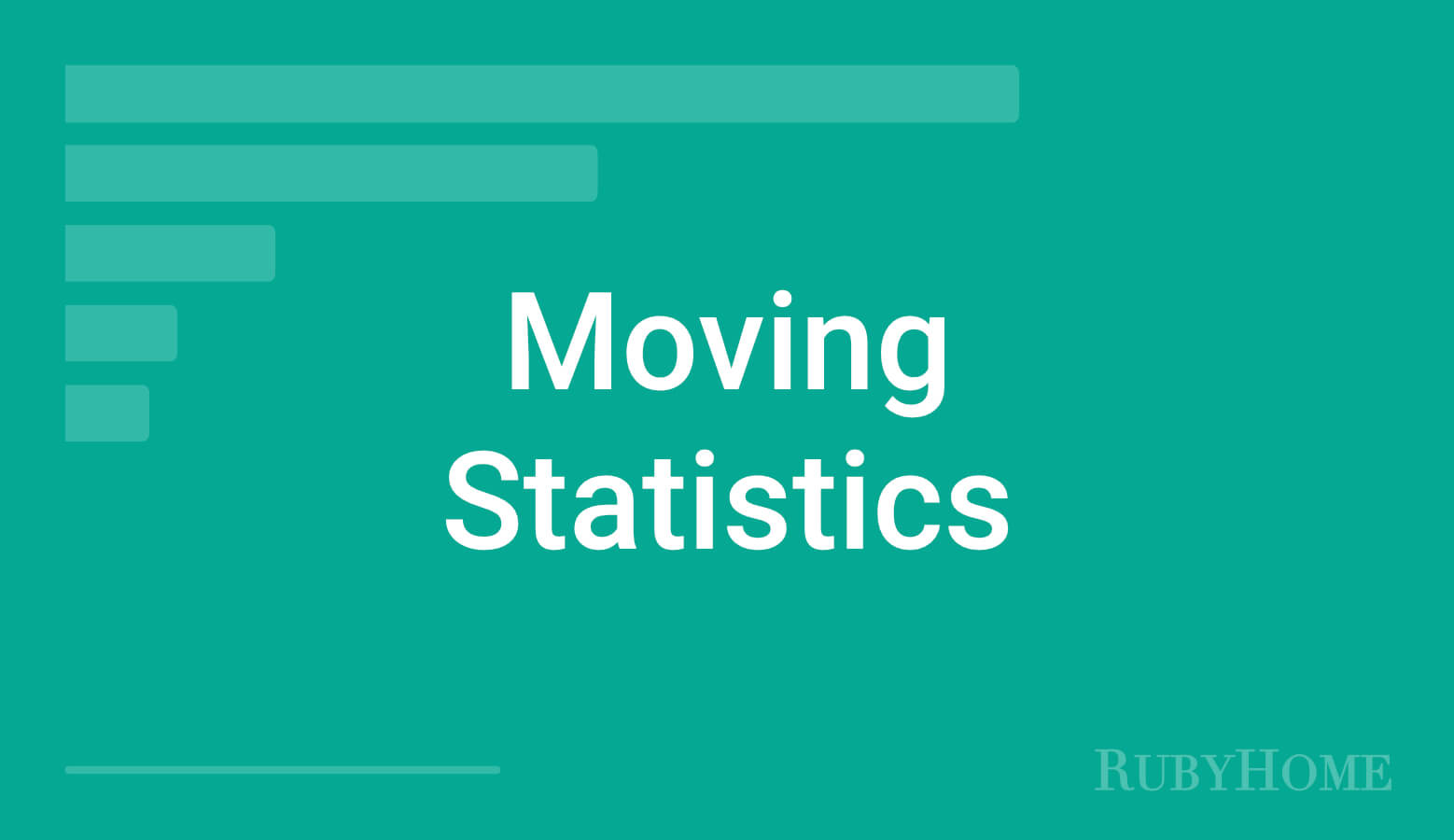
2021 moving trends saw the lowest number of people moving in decades, and the current moving rates are less than half of what they were in the 1940s.
Like pre-Covid moving trends, people moved to warmer states and less densely populated cities & suburbs. The search for more affordable housing prices remained the most important reason for local moves, while jobs were most important for long-distance moves. Moving industry statistics showed a funny thing, though: when large numbers of people moved to the same low-density areas in pursuit of affordable housing, those migrations – particularly to the South and West – increased the housing prices in these regions by nearly 33%.
We’ve collected and analyzed the most recent moving industry statistics, and here is a summary of our findings:
Key Moving Stats
- 8.4% of Americans moved in 2021.
- The moving rate was the lowest historical annual rate recorded since 1948.
- 27,059,000 Americans moved in 2021.

- Nearly 50% of all movers stated housing prices as the main reason.
- Young adults between the ages of 20-29 move the most.
- A person in the United States can expect to move 11.7 times in their lifetime.
- In 2021, Florida gained the most population, and California lost the most population among all the states.
- There are about 7,000 moving companies in the United States.
How Many People Move Each Year?
27,059,000 people moved in 2021, down from 34,902,000 million in 2017.
Percentage-wise, that’s about 8.4% of the U.S. population and that’s the lowest annual rate recorded since 1948.
Current mobility rates are half what they were in the 1940s – when one in five Americans moved each year – and have been steadily declining since the mid-1980s.
According to U.S. Census data, in the past five years, the annual mover rates and the number of movers fell yearly, despite the national population growth.
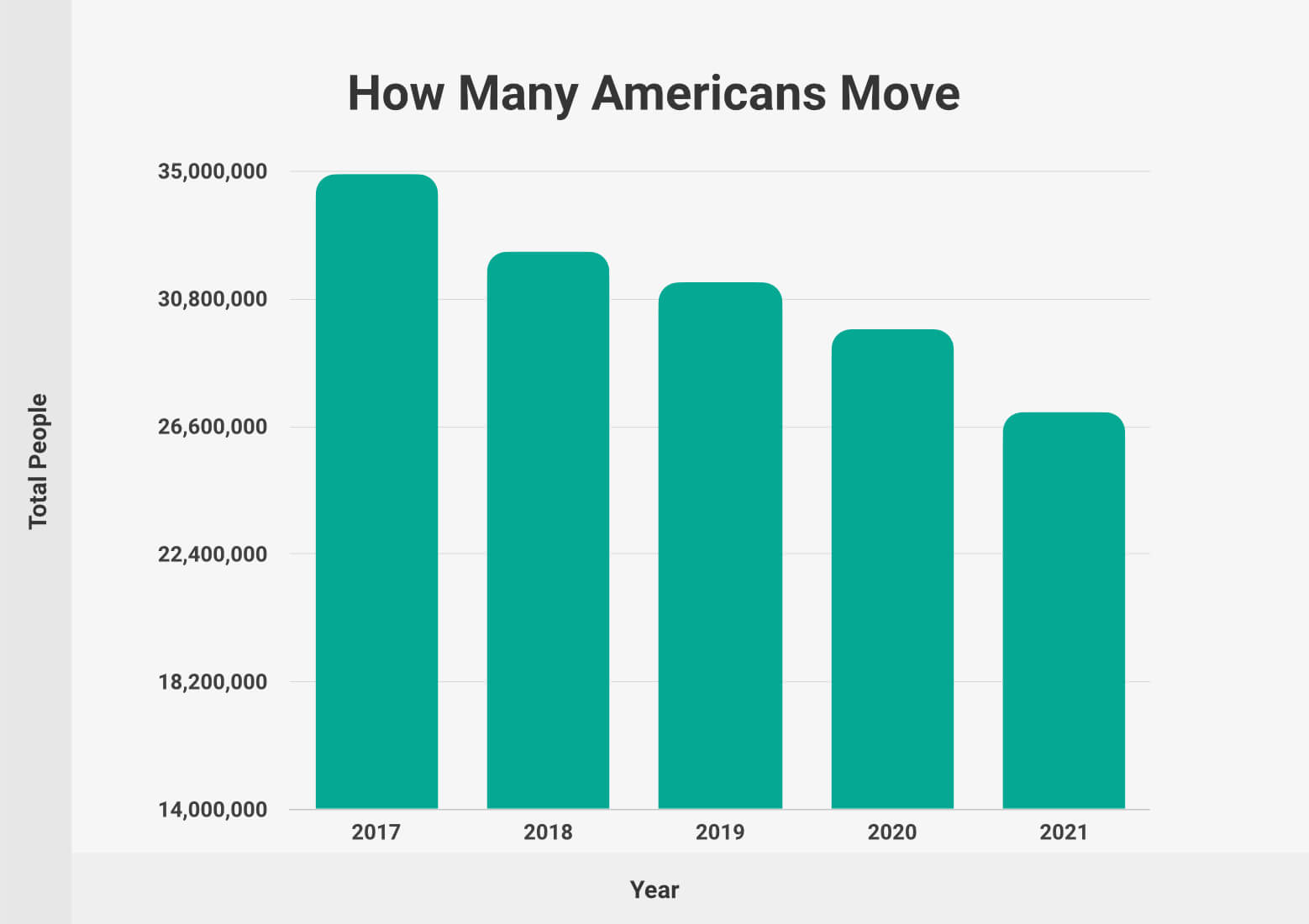
The table below shows the number of people who moved each year from 2017 to 2021:
| Year | Number of People Moved |
|---|---|
| 2017 | 34,902,000 |
| 2018 | 32,352,000 |
| 2019 | 31,371,000 |
| 2020 | 29,780,000 |
| 2021 | 27,059,000 |
8.4% of the U.S. population moved in 2021, the lowest rate in recent years.
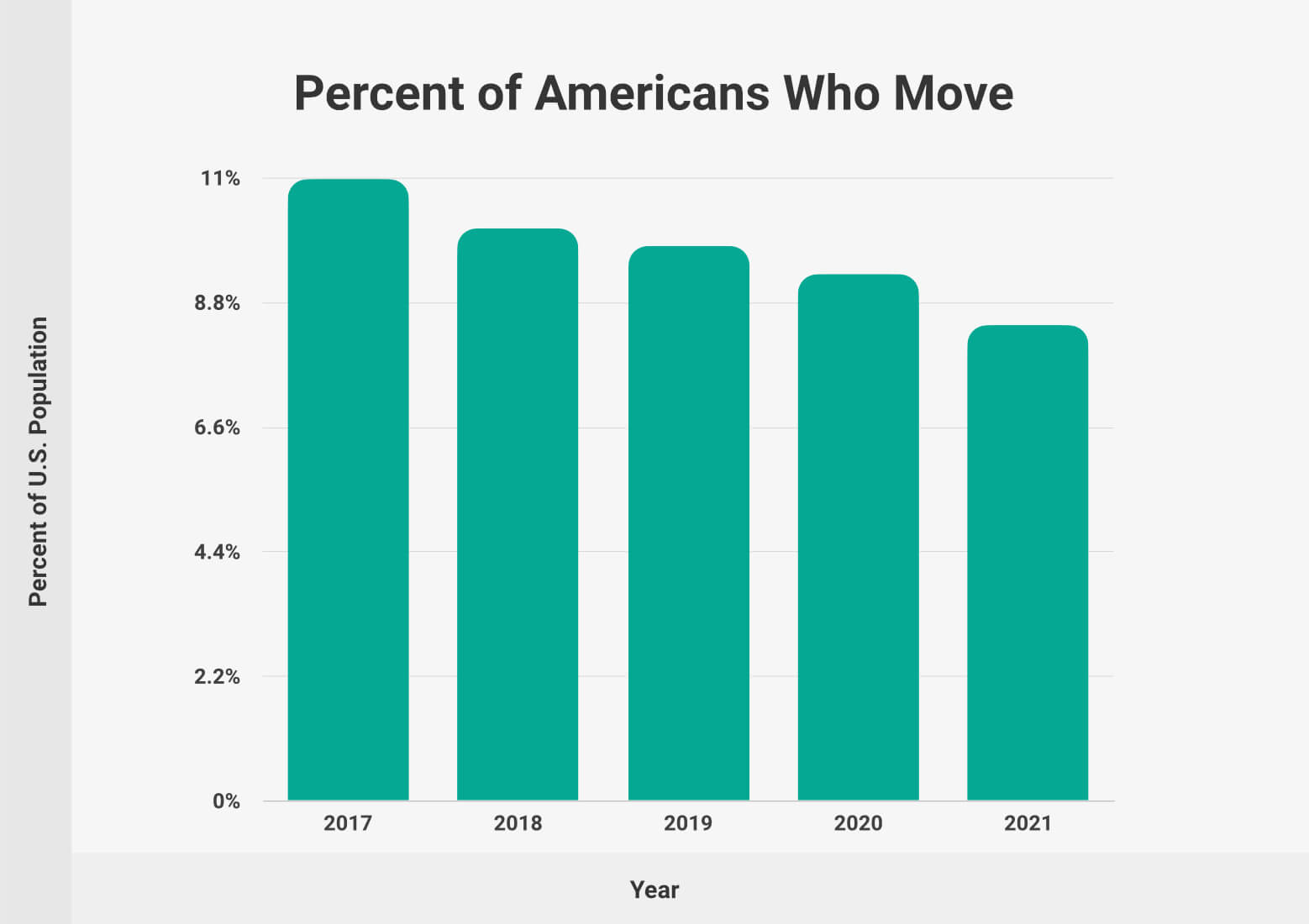
Here is a table showing the percentage of the U.S. population that moved from 2017 to 2021:
| Year | Percentage of People Moved |
|---|---|
| 2017 | 11% |
| 2018 | 10.1% |
| 2019 | 9.8% |
| 2020 | 9.3% |
| 2021 | 8.4% |
Source: U.S. Census
Where Are People Moving?
Historically, people moved for various reasons — whether across the country or the globe — like living in a better climate, economic opportunities, and a better future.
Presently, and within the United States, these reasons still hold up as primary motivators for people to move from one state or region to another.
Net Migration by Region
In 2021, the South gained about 253,000 people from migration, while the Northeast lost about 227,000.
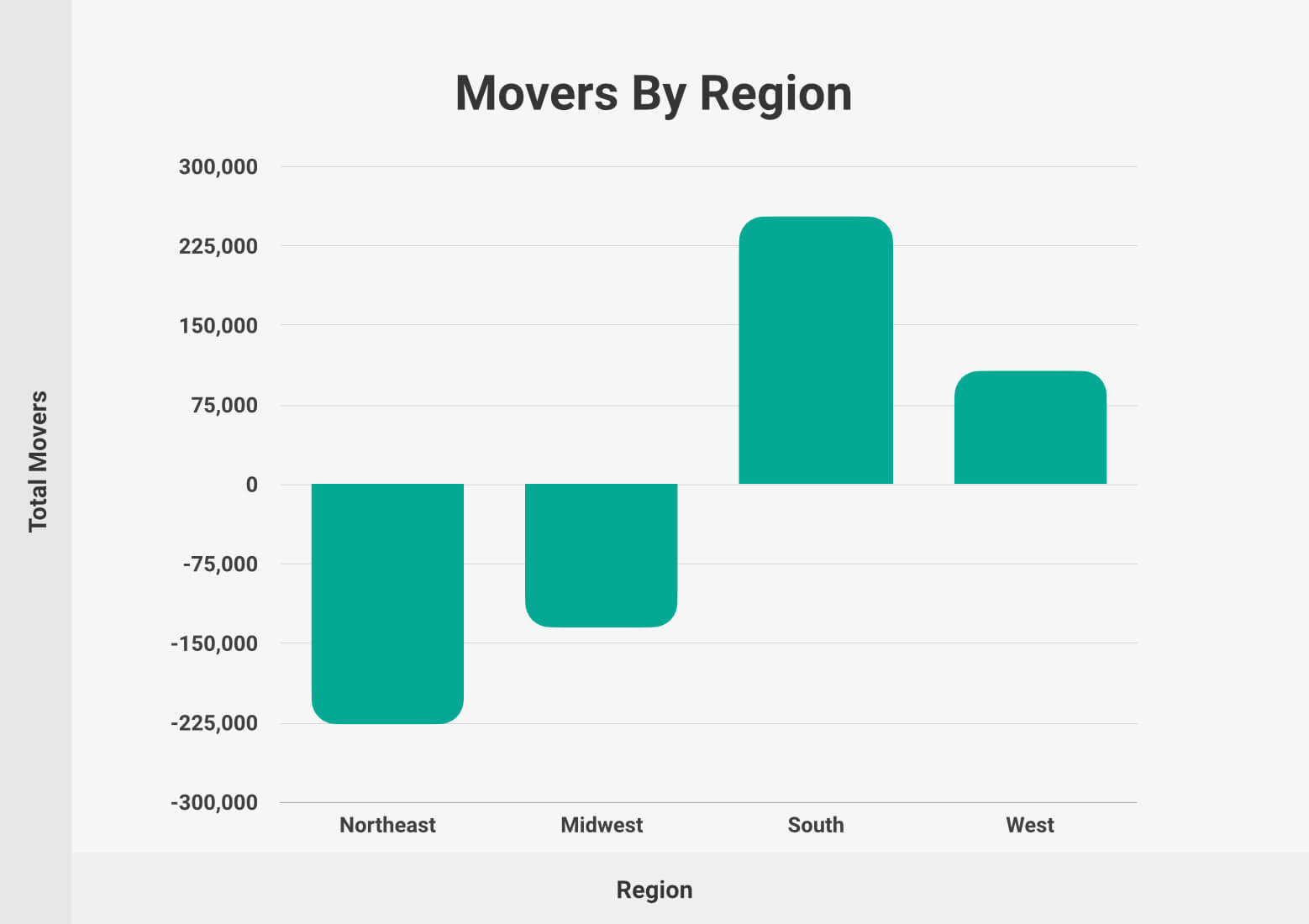
This table summarizes the net moving inflow/outflow per region in 2021:
| Region | Net Migration |
|---|---|
| Northeast | -227,000 |
| Midwest | -134,000 |
| South | 253,000 |
| West | 108,000 |
Between 2017 and 2020, the Midwest and West did not experience statistically significant gains or losses. Additionally, the South experienced net gains, and the Northeast experienced net losses.
Here’s a table showing the net inflow/outflow per region from 2017 to 2020:
| Region | 2017 | 2018 | 2019 | 2020 |
|---|---|---|---|---|
| Region | 2017 | 2018 | 2019 | 2020 |
| Northeast | -200,000 | -352000 | -238000 | -165000 |
| Midwest | -25,000 | -38000 | 17000 | -54000 |
| South | 44,000 | 512000 | 263000 | 370000 |
| West | 181,000 | -122000 | -141000 | -151000 |
Source: U.S. Census
The Northeast has continued its population losing streak because of its harsh winters, high cost of living (New York, Massachusetts, and Washington, D.C. are 3 out of 5 most expensive places in the U.S.) and limited job availability (Google, Apple, Dropbox, Oracle and other tech and non-tech large employers have recently moved or expanded their operations out of the Northeast and into less costly regions, such as Texas).
Net Migration by State
State-to-state U.S. migration is driven by the same reasons that motivate people to move across the regions: warmer climate, affordable housing, and available employment.
In 2021, Florida took the top spot for net migration gain, with 220,890 more people moving into the state than leaving it, followed by Texas, Arizona, North Carolina, and South Carolina.
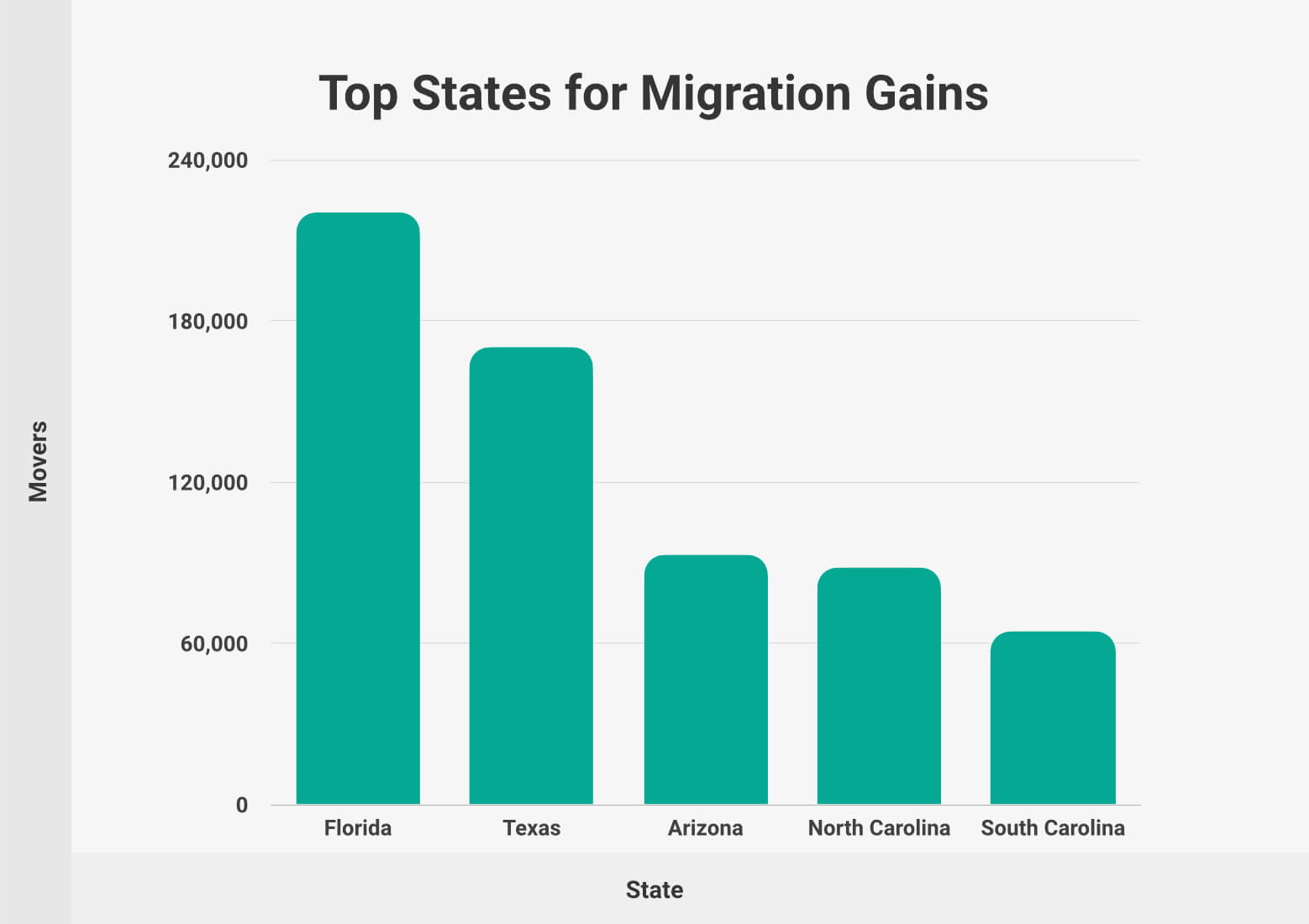
Below are tables showing the 2021 net migration gains by the number of people for the top 5 states.
| State | Net Gain |
|---|---|
| Floria | 220,890 |
| Texas | 170,307 |
| Arizona | 93,026 |
| North Carolina | 88,673 |
| South Carolina | 64,833 |
The largest net loss was California where 367,299 people left, followed by New York, Illinois, Massachusetts, and Louisiana.
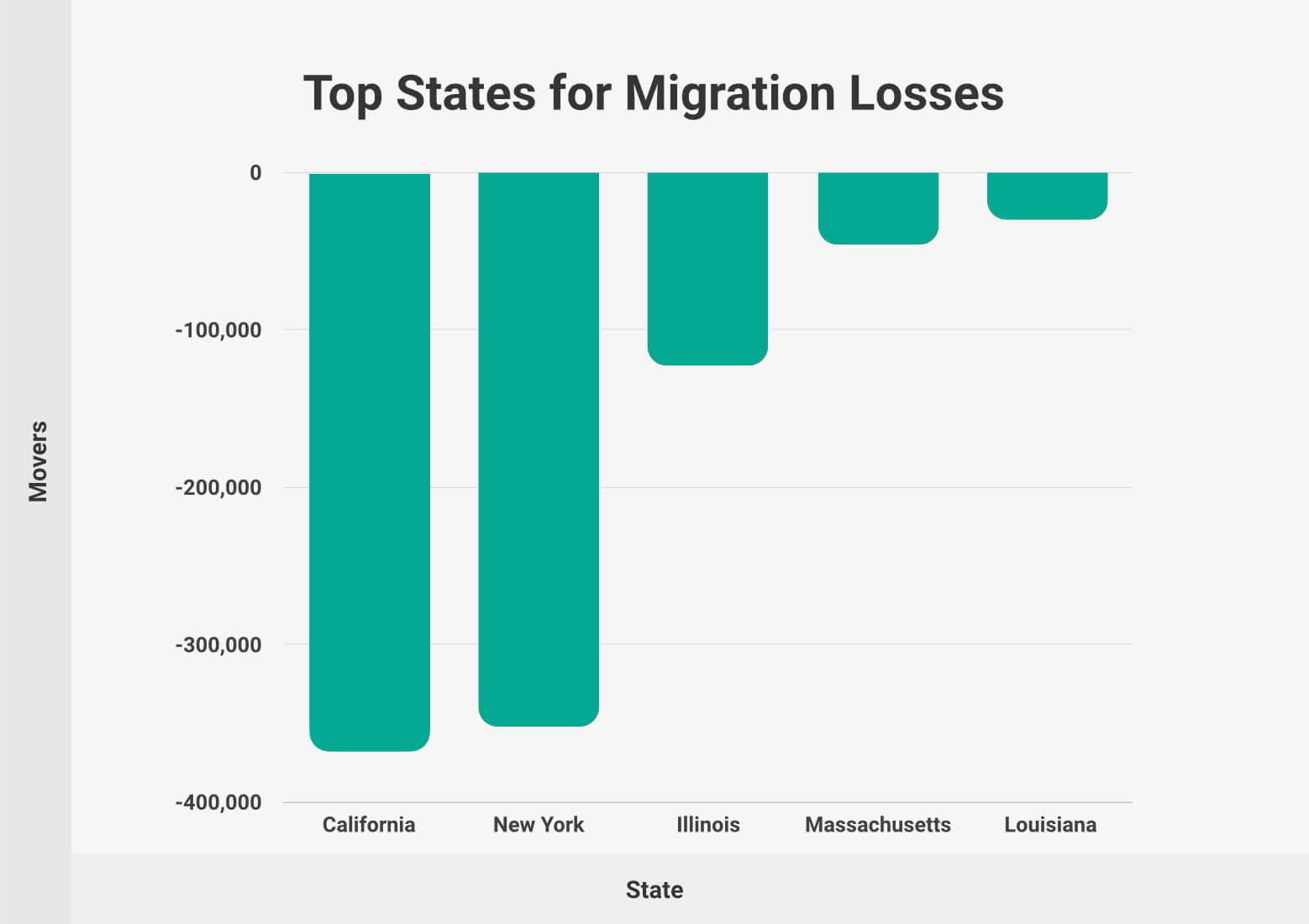
The table below shows the 2021 net migration losses by the number of people for the top five states.
| State | Net Loss |
|---|---|
| California | -367,299 |
| New York | -352,185 |
| Illinois | -122,460 |
| Massachusetts | -46,187 |
| Lousiana | -30,312 |
Source: U.S. Census
While Florida and California both are highly coveted states, with the year-round warmer weather, the biggest differences in attracting the movers seem to be the cost of living and housing prices.
Even with the 22% increase over last year, the median home price in Florida is still less than half of the median home price in California – $410,000 vs. $900,000.
Net Migration by Metro Area
People have been moving outward, from the most densely populated cities to less populated cities and suburbs.
According to the research by the Brookings Institute, in 2021, all major metro areas (with a population over 1 million) saw a cumulative decline in growth of 0.16% over the previous year, while non-major metro areas and non-metro areas experienced growth of 0.6% and 0.25%, respectively. Here’s a table showing 2021 year-over-year growth and loss rates in population comparing metro and non-metro areas.
| Type of Area | Annual Growth Rate |
|---|---|
| Non-major metros | 0.60% |
| Non-metros | 0.25% |
| Major metro areas | -0.16% |
The major metro areas with biggest gains in 2020-21 were located in the Sun Belt, especially Texas, Florida, Arizona, North Carolina, and Georgia. Dallas (+97,290) led the list, followed by Phoenix, Houston, and Austin, Texas.
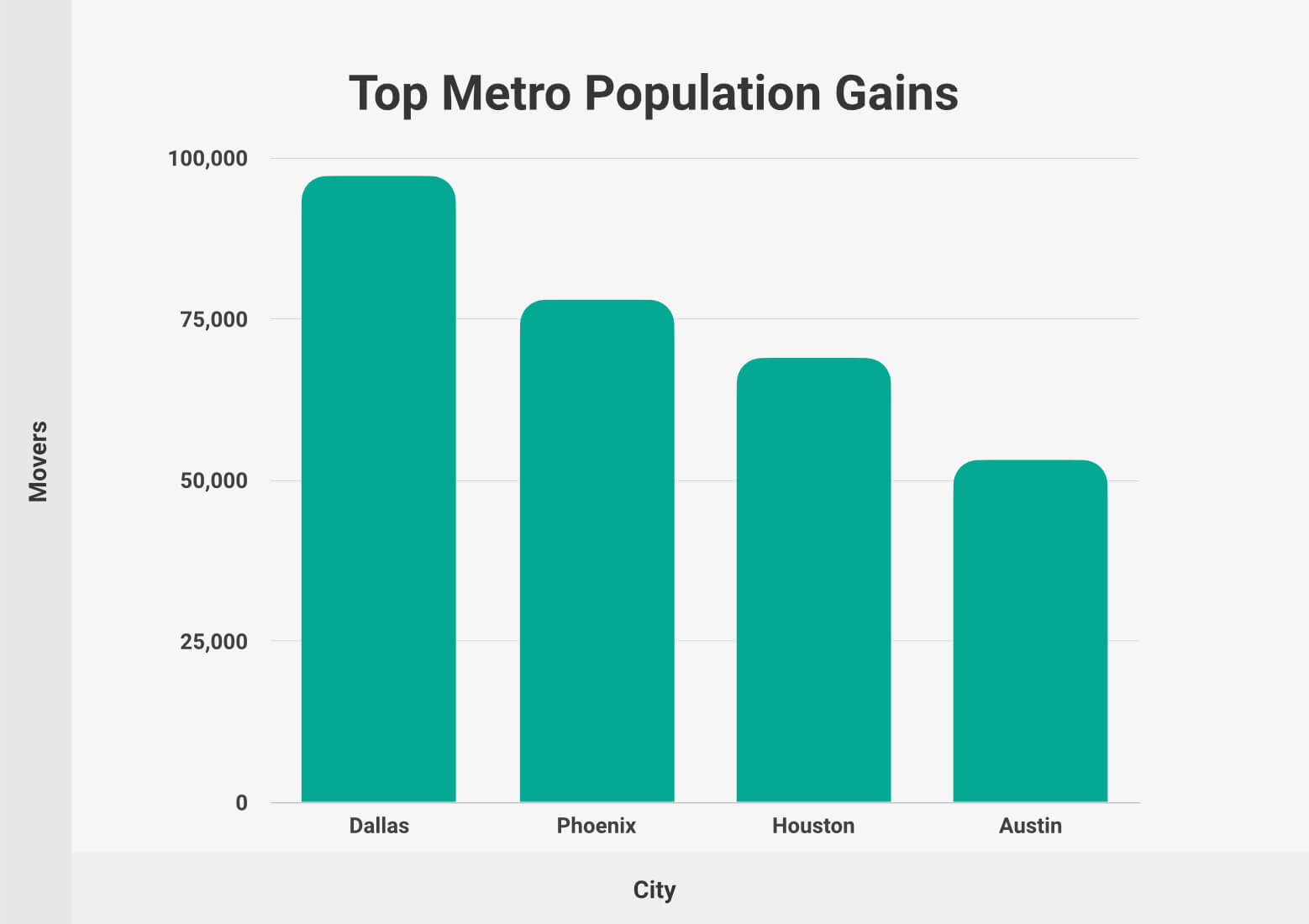
Here’s a table showing the areas with the greatest population gains in 2021.
| Top Metros With Gains | Population Gain |
|---|---|
| Dallas | 97,290 |
| Phoenix | 78,220 |
| Houston | 69,094 |
| Austin | 53,301 |
Metro areas with population losses are primarily located in coastal areas, the industrial Midwest, and parts of the South. Those with the greatest numeric losses are New York (-327,955), followed by Los Angeles, San Francisco, and Chicago.
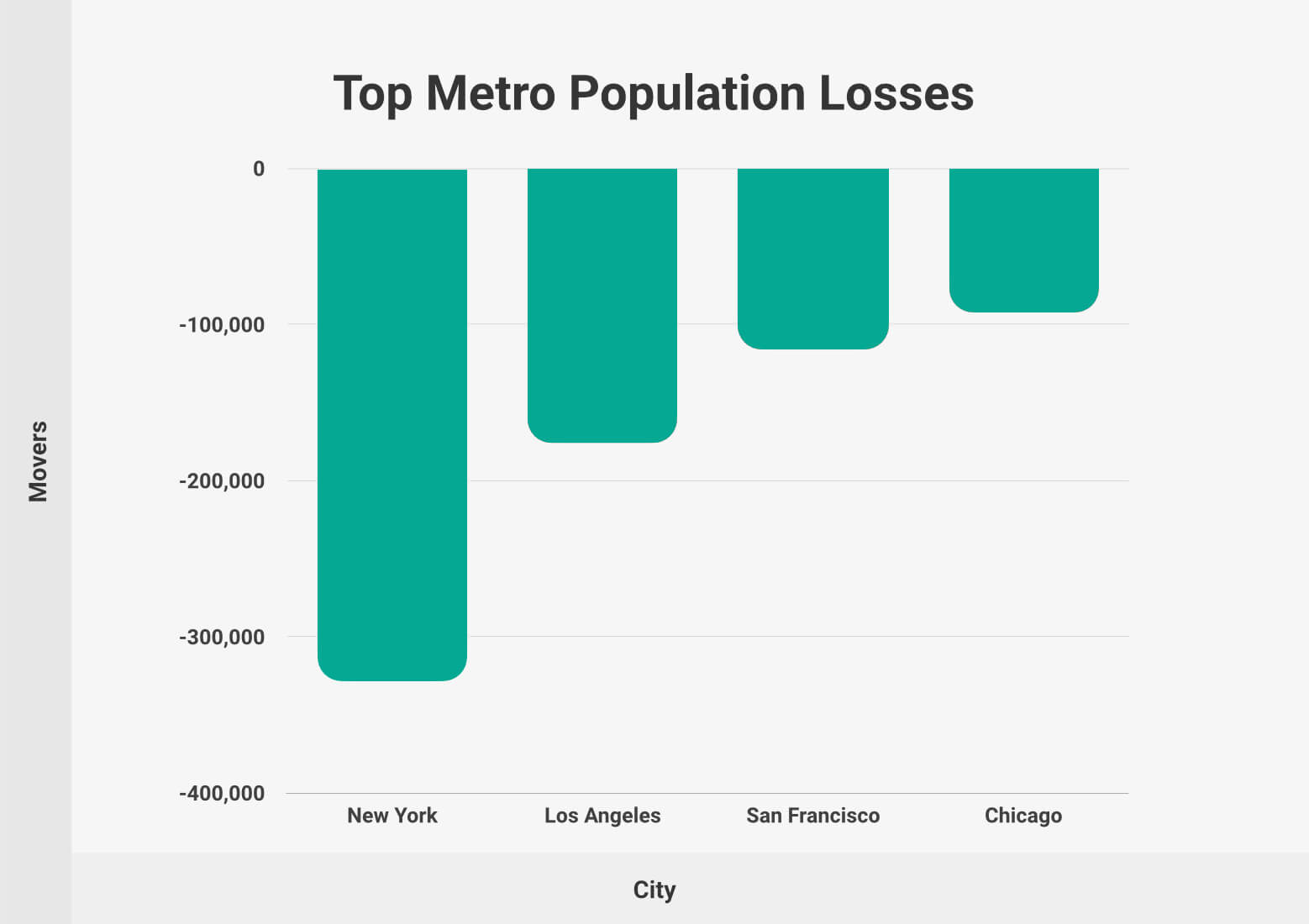
Here is the breakdown of top metros with the most significant population losses in 2021.
| Top Metros With Losses | Population Loss |
|---|---|
| New York | -327,955 |
| Los Angeles | -175,913 |
| San Francisco | -116,385 |
| Chicago | -91,671 |
Source: Brookings
Why Do People Move?
People move for various reasons, but the most common motivator is more affordable housing, especially during pandemic years.
According to the U.S. Census, nearly half of all movers in 2021 cited housing-related reasons. The next-most prevalent reasons for moving in 2021 were related to family, jobs, and other reasons (in diminishing order).
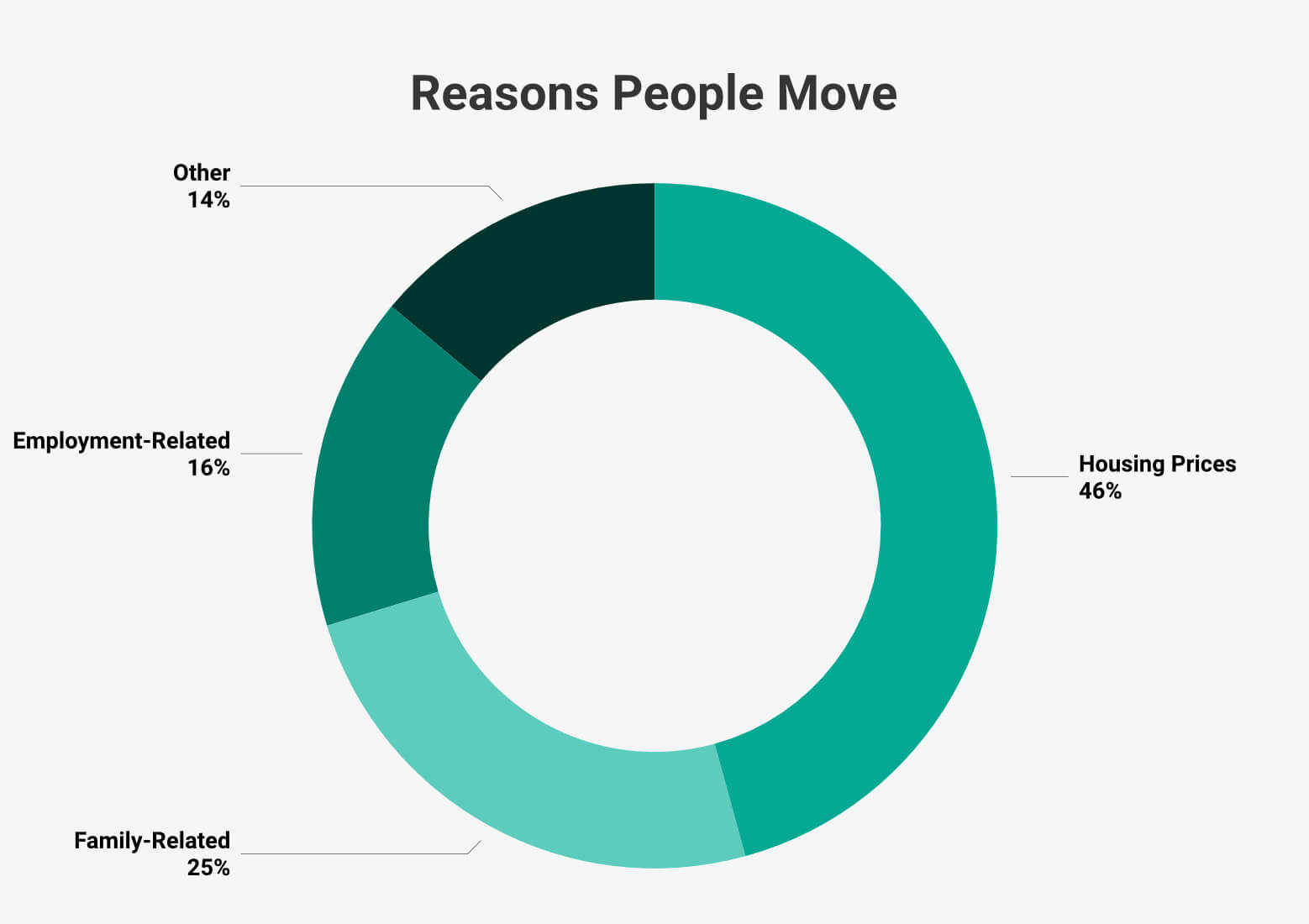
Here’s a table showing the principal reasons for moving within the U.S. in 2021, based on the CPS Migration/ Geographic Mobility Census data.
| Reason for Move | Percentage of Movers |
|---|---|
| Housing Prices | 45.73% |
| Family-Related | 24.56% |
| Employment-Related | 15.77% |
| Other | 13.94% |
Similarly, in 2017-2020, housing prices were the most prevalent reason for moving, followed by family-related, job-related, and other reasons. Here’s a table showing the reasons people moved from 2017 to 2020.
| Reason for Move | 2017 | 2018 | 2019 | 2020 |
|---|---|---|---|---|
| Housing Prices | 43.0% | 41.5% | 40.4% | 40.2% |
| Family-Related | 27.9% | 28.1% | 26.8% | 25.5% |
| Employment-Related | 18.5% | 19.7% | 21.2% | 19.8% |
| Other | 10.6% | 10.7% | 11.6% | 14.6% |
Source: U.S. Census
It’s worth pointing out that most people move locally – thus, the prevalent reasons in this section are the primary motivators for local moves.
For long-distance moves, the main reason becomes jobs, followed by housing prices, except for older Americans, who primarily move to be closer to their family. A better climate also becomes a significant motivator for moving long-distance.
How Far Do People Move?
Most movers don’t go far.
In 2021, less than one-fifth of all American movers changed states, while more than half moved within the same county.
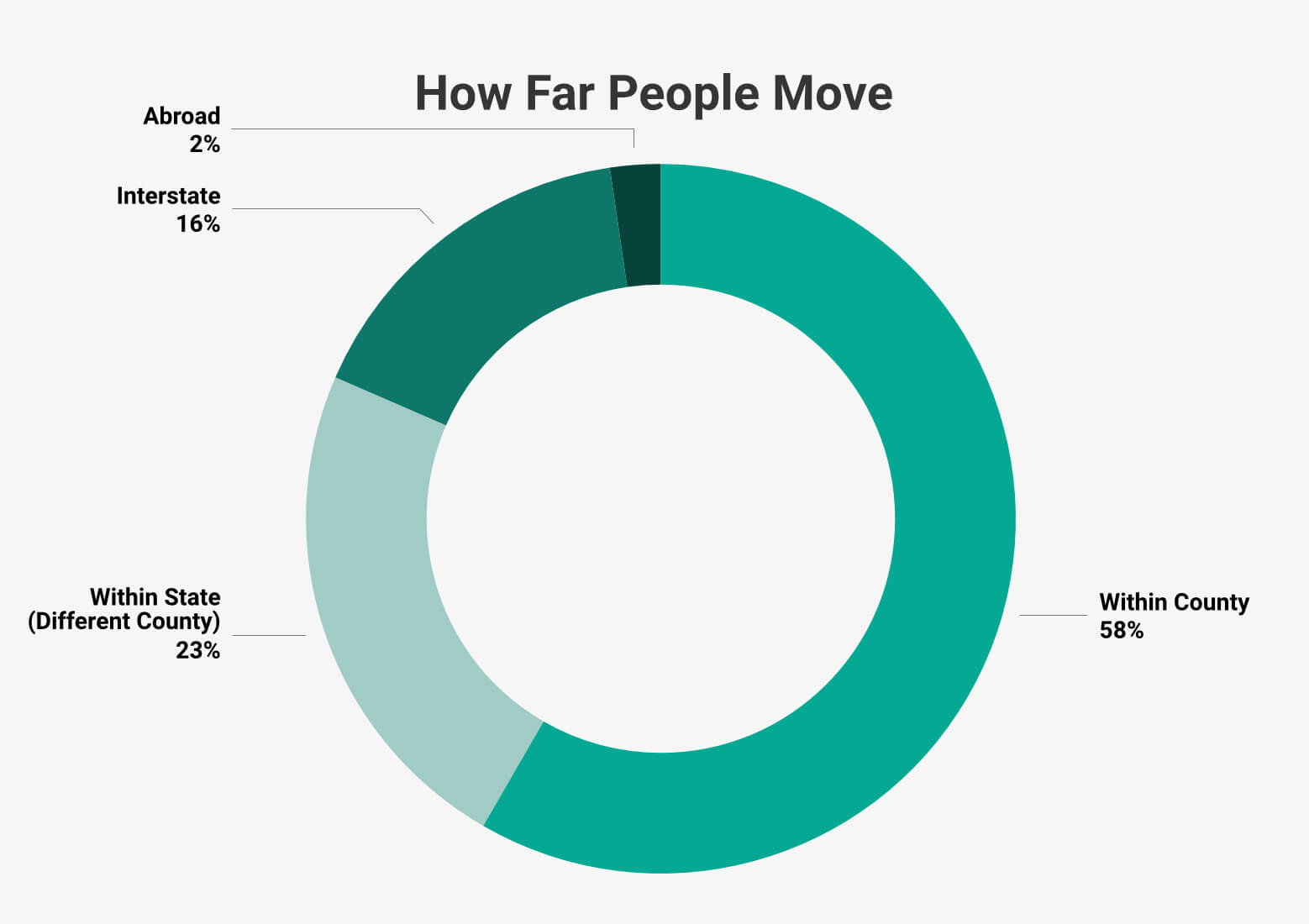
The table below shows a breakdown of the type of move, based on the Census 2020-2021 moving industry data.
| Moving Distance | Percentage of Movers |
|---|---|
| Within County | 58.4% |
| Within State (Different County) | 23.2% |
| Interstate | 16.2% |
| Abroad | 2.3% |
Interestingly, the 2021 breakdown of moving types is very similar to the breakdown in the past five years, despite their differences in the moving rates. Every year between 2017-2020, the vast majority of moves were local, with less than a fifth of all movers leaving their state and about 60% moving within the same county. Here’s a table showing a breakdown by moving type for 2017-2020, based on the Census data.
| Moving Distance | 2017 | 2018 | 2019 | 2020 |
|---|---|---|---|---|
| Within County | 61.9% | 61.4% | 60.0% | 58.8% |
| Within State (Different County) | 19.1% | 20.1% | 21.2% | 23.7% |
| Interstate | 15.4% | 15.0% | 15.1% | 14.2% |
| Abroad | 3.6% | 3.6% | 3.6% | 3.2% |
Source: U.S. Census
Why Are Moving Rates Declining?
While there’s little consensus as to why Americans are moving less than in the past, the three factors that seem to play a role are a demographic change, housing affordability, and changes in labor dynamics.
According to Harvard’s Joint Center for Housing Studies and World Economic Forum:
- People move less often as they age, and young adults between the ages of 20-29 move the most. As baby boomers (America’s largest generation, between 57-75 years old) and millennials (2nd largest generation, between 25-40 years old) age out of their most mobile years, some decline in moving seems to be natural.
- U.S. housing affordability could also be depressing the moving rates, with high housing prices for renting and owning discouraging moves into attractive but unaffordable areas.
- The rise in dual-income households and increasing working-from-home opportunities could also negatively affect mobility (single-income earners and commuters have higher mobility rates).
Source: Harvard Joint Center for Housing Studies
Migration’s Effect on Housing Prices
While high housing prices are a significant motivator for moving, the relationship between moving trends and housing price increases is related.
When many people move into the same area, they create an increased demand for affordable housing. In fast-growing markets, the increased demand for housing often creates housing inventory shortages, which, in turn, increase housing prices. Thus, continuous migration (especially in a short time frame) into the same area eventually makes the market unaffordable, creating a moving outflow from this area.
The new research by Freddie Mac, the federal home loan mortgage corporation, supports this theory.
According to Freddie Mac, the most recent significant migration period to the South and West (2020-2022) was initially motivated by the lower median prices of homes in these regions compared with regions from which people moved.
In the top 10 destinations in the South and West, the median home prices were $128,000 and $144,000 less (respectively) compared to the median home prices in the areas of origin. However, the inflow of new residents into the South and West drove up the median home prices by 33% over the past 2 years, making these markets less and less affordable.
Other factors, such as low mortgage interest rates and housing shortages in the South and West, also contributed to the housing price increases.
Source: Freddie Mac